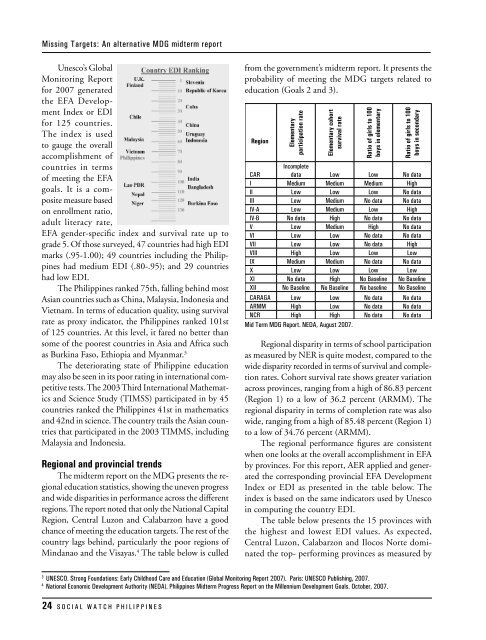one big file - Social Watch
one big file - Social Watch
one big file - Social Watch
Create successful ePaper yourself
Turn your PDF publications into a flip-book with our unique Google optimized e-Paper software.
Missing Targets: An alternative MDG midterm report<br />
Unesco’s Global<br />
Monitoring Report<br />
for 2007 generated<br />
the EFA Development<br />
Index or EDI<br />
for 125 countries.<br />
The index is used<br />
to gauge the overall<br />
accomplishment of<br />
countries in terms<br />
of meeting the EFA<br />
goals. It is a composite<br />
measure based<br />
on enrollment ratio,<br />
adult literacy rate,<br />
EFA gender-specific index and survival rate up to<br />
grade 5. Of those surveyed, 47 countries had high EDI<br />
marks (.95-1.00); 49 countries including the Philippines<br />
had medium EDI (.80-.95); and 29 countries<br />
had low EDI.<br />
The Philippines ranked 75th, falling behind most<br />
Asian countries such as China, Malaysia, Ind<strong>one</strong>sia and<br />
Vietnam. In terms of education quality, using survival<br />
rate as proxy indicator, the Philippines ranked 101st<br />
of 125 countries. At this level, it fared no better than<br />
some of the poorest countries in Asia and Africa such<br />
as Burkina Faso, Ethiopia and Myanmar. 3<br />
The deteriorating state of Philippine education<br />
may also be seen in its poor rating in international competitive<br />
tests. The 2003 Third International Mathematics<br />
and Science Study (TIMSS) participated in by 45<br />
countries ranked the Philippines 41st in mathematics<br />
and 42nd in science. The country trails the Asian countries<br />
that participated in the 2003 TIMMS, including<br />
Malaysia and Ind<strong>one</strong>sia.<br />
Regional and provincial trends<br />
The midterm report on the MDG presents the regional<br />
education statistics, showing the uneven progress<br />
and wide disparities in performance across the different<br />
regions. The report noted that only the National Capital<br />
Region, Central Luzon and Calabarzon have a good<br />
chance of meeting the education targets. The rest of the<br />
country lags behind, particularly the poor regions of<br />
Mindanao and the Visayas. 4 The table below is culled<br />
from the government’s midterm report. It presents the<br />
probability of meeting the MDG targets related to<br />
education (Goals 2 and 3).<br />
Region<br />
Elementary<br />
participation rate<br />
Elementary cohort<br />
survival rate<br />
Ratio of girls to 100<br />
boys in elementary<br />
Ratio of girls to 100<br />
boys in secondary<br />
CAR<br />
Incomplete<br />
data Low Low No data<br />
I Medium Medium Medium High<br />
II Low Low Low No data<br />
III Low Medium No data No data<br />
IV-A Low Medium Low High<br />
IV-B No data High No data No data<br />
V Low Medium High No data<br />
VI Low Low No data No data<br />
VII Low Low No data High<br />
VIII High Low Low Low<br />
IX Medium Medium No data No data<br />
X Low Low Low Low<br />
XI No data High No Baseline No Baseline<br />
XII No Baseline No Baseline No baseline No Baseline<br />
CARAGA Low Low No data No data<br />
ARMM High Low No data No data<br />
NCR High High No data No data<br />
Mid Term MDG Report. NEDA, August 2007.<br />
Regional disparity in terms of school participation<br />
as measured by NER is quite modest, compared to the<br />
wide disparity recorded in terms of survival and completion<br />
rates. Cohort survival rate shows greater variation<br />
across provinces, ranging from a high of 86.83 percent<br />
(Region 1) to a low of 36.2 percent (ARMM). The<br />
regional disparity in terms of completion rate was also<br />
wide, ranging from a high of 85.48 percent (Region 1)<br />
to a low of 34.76 percent (ARMM).<br />
The regional performance figures are consistent<br />
when <strong>one</strong> looks at the overall accomplishment in EFA<br />
by provinces. For this report, AER applied and generated<br />
the corresponding provincial EFA Development<br />
Index or EDI as presented in the table below. The<br />
index is based on the same indicators used by Unesco<br />
in computing the country EDI.<br />
The table below presents the 15 provinces with<br />
the highest and lowest EDI values. As expected,<br />
Central Luzon, Calabarzon and Ilocos Norte dominated<br />
the top- performing provinces as measured by<br />
3<br />
UNESCO. Strong Foundations: Early Childhood Care and Education (Global Monitoring Report 2007). Paris: UNESCO Publishing, 2007.<br />
4<br />
National Economic Development Authority (NEDA). Philippines Midterm Progress Report on the Millennium Development Goals. October, 2007.<br />
24 S O C I A L W A T C H P H I L I P P I N E S

















